Portland State University professor Dr Tomas Cotik gives an introduction to kinesthetic feelings and demonstrates techniques and exercises
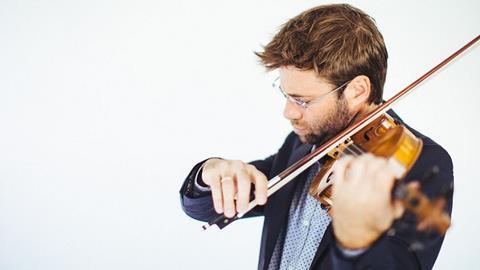
This article follows Dr Tomas Cotik’s previous feature for The Strad: Developing a natural and relaxed approach to string playing - part 1
The goal of the following exercises is to help students experience new kinesthetic feelings. These practical methods allow students to crack subconscious habits and release tensions. Once kinesthetic feelings have been accessed, students may simply practise recalling the sensation of letting go until it becomes second nature while playing.
• Practice extensions by releasing/relaxing the muscles instead of pushing them to force the reach. Ultimately, try to find fingerings that don’t create tension as these are destined to fail in performance. Try retro extensions between fingers to see how it’s possible to reach further with a release instead of with tension.
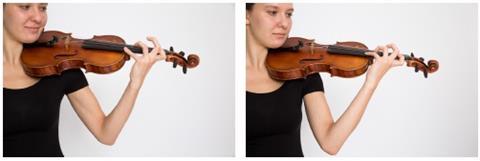
• Thumb in upper positions: consider releasing the thumb to have the hand in a comfortable position. (Note: without a shoulder rest this might not be possible.) The hand needs to be free in order to play in tune and for the fingers to have ease of movement.
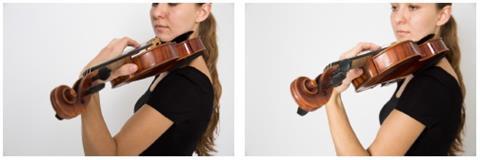
• Imagine your bow is a sword and play with it, moving it through the air, keeping every part of your body relaxed. (This is a great exercise for beginners, to gain confidence with the bow as part or an extension of their bodies).

• Imagine there is a balloon under your elbow. Maintain that feeling and ease when you play.
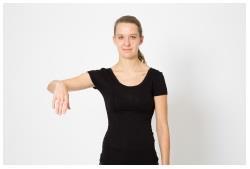
• Move your right elbow up and down and try the extremes to know the territory and make sure you are not stuck in one position.

• Imagine a fly tied to a string. Imagine your hand is the fly and your arm is the flexible string that allows it to go anywhere without resistance. Contrast this feeling with trying to reach those places from your shoulder.
• Rest (without moving) different parts of the arm and move the other joints to 'get in touch' with your body and develop more relaxation tools. You can use a stand to support your elbow, forearm or hand to work on a specific part while releasing the others.

• Bow exercises to 'wake up' fingers and become more aware of how they move and feel. I recommend doing these exercises with the right arm straight ahead at a ninety-degree angle from the body. It is also a good idea to do them with a pencil instead of the bow:
• Windshield wiper. (Use only your pinky to do this movement).

• Bring the bow up and down. Thumb and the four opposing fingers extend and retract.

• Bring the bow up and down using a diagonal finger pattern. Begin with a normal bow hold. Go down and forward (fingers in direction to the tip of the bow), then up to the original position, then down and back (fingers in direction to the frog). Repeat.

• Lift different fingers repeatedly.

• Lift different combinations of fingers repeatedly. (For example, index and ring, middle and pinky, etc.) Play using different combinations to experience the responsibilities of the different fingers.

• Hold the bow without the thumb. Move the thumb freely around. Do this above a bed to protect your bow if it falls. (Tip: the middle finger holds the bow from below, and the other fingers lean and hold from the top).

• Push the thumb with another finger to make sure the joint is flexible and not locked.
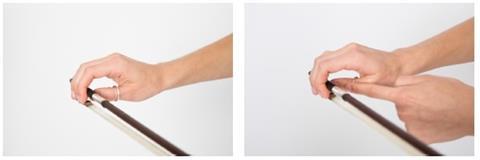
• Walk with your fingers towards the tip. Move the fingers in the following order: index, middle, thumb, ring, pinky. The bow shouldn’t move. You can try some of these exercises holding the bow the other way round, closer to the tip. Your pinky will have to work harder.

• Holding the bow, move your fingers as if to type letters in the air on an imaginary surface. You could first try this on a plane that is parallel to how you are standing and then on a plane that is perpendicular.
• Walk while playing.
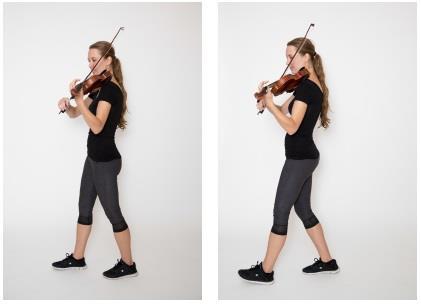
• While you play, move up and down by bending your legs.
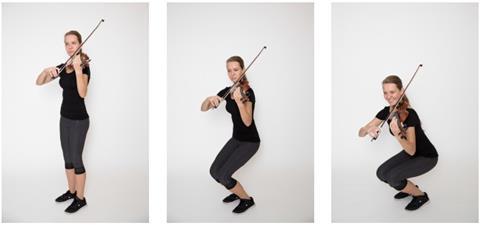
• Rotate your hips while you play.
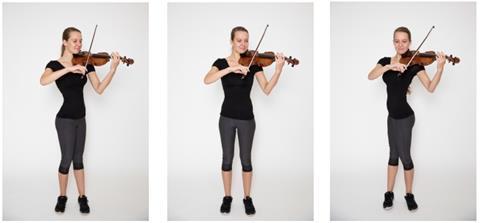
• Rotate your torso while you play. The goal in these exercises is for you to make sure you are not locking any part of your body.

You should aim to eventually integrate all these kinesthetic feelings into a whole-body sensation - a control that is fluid and lively, enhancing performance and helping avoid unnecessary tensions. Find an image or a couple of words that help you recall this feeling and use that image, word, or phrase periodically when you play. Make sure you are using your body in an optimal way, as well as counteracting any old, undesired habits.
It is very important not to confuse the concepts described in this article with playing that is lacking in energy. The goal of these techniques is to allow the energy to flow directly through the music instead of becoming locked in a joint or part of your body. The aim is to integrate the body as a whole. This will improve the use of all body parts. Doing this ultimately helps us to free our movements, feel physically better, and enables us to channel all of our energy into producing a beautiful sound, allowing nothing to interfere with the music.
This article follows Dr Tomas Cotik's presentation and article on Alexander Technique presented at the American String Teachers Association Conference 2016. The 2017 conference takes place from 1-4 March.
*Any injury sustained from the proper or improper use of these exercises is solely the responsibility of the person who follows the exercises. Tomas Cotik and his partners disclaim any liability from injury or damages to the instrument and/or bow caused from the use of these exercises.
Some concepts are described in greater depth in the following articles:
• William Conable, “The Alexander Technique,” Journal of the Violin Society of America, 13, no. 1 (1993), 126-132.
• Charles Jay Stein, “The Alexander Technique: Its Basic Principles Applied to the Teaching and Performing of Stringed Instruments,” American String Teacher, 49:3 (August 1999), 75-77.
Dr Tomas Cotik teaches at Portland State University. He regularly gives masterclasses and lectures throughout the US. Hailed by Michael Tilson Thomas as ‘an excellent violinist’, Tomas Cotik was a first-prize winner at the National Broadcast Music Competition in his native Argentina in 1997, and the winner of the Government of Canada Award for 2003-2005. A prolific recording artist, Dr Cotik is currently involved with more than a dozen CDs, which include Schubert’s complete works for violin and piano and Mozart’s 16 sonatas. A former rotating concertmaster of the New World Symphony, Cotik has worked closely with members of the Cleveland, Miami, Pro Arte, Vogler, Vermeer, Tokyo and Endellion String Quartets. Dr Cotik is a currently a member of the Cotik/Lin duo.
Photos: So-Ming Kang
Student, model, and assistant: Patricia Jancova
Read: Elements of Alexander Technique: discovering a natural approach to string playing
































No comments yet